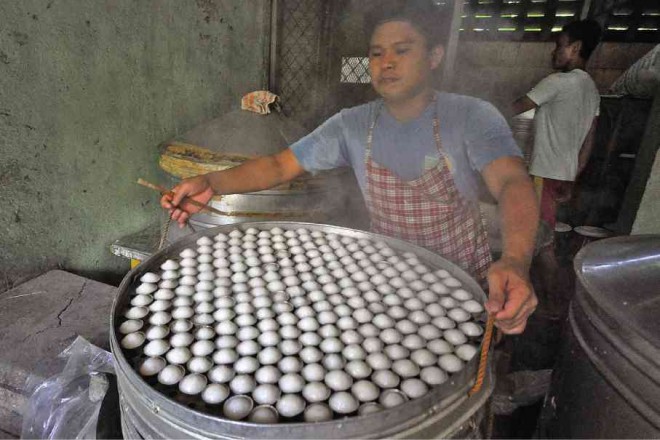
“PUTO” (rice cake) makers of Barangay Dinalaoan in Calasiao town, Pangasinan province, prepare the day’s production for packaging. The bite-sized, soft rice cakes are then shipped to the different provinces and Metro Manila. WILLIE LOMIBAO/CONTRIBUTOR
CALASIAO, Pangasinan— Agriculturists and farmers here have bred a rice variety which, they say, is best suited for making “puto” (rice cake), a product that this town in central Pangasinan province is known for.
The “Calasiao rice” variety was introduced during Farmers’ Day on Monday as part of the 12-day Puto Festival celebration that started on Saturday.
“We will be displaying two sets of puto, one made from Calasiao rice and the other from ordinary rice. We will let the public decide [on the variety that best suits their taste],” Mayor Mark Roy Macanlalay said.
The Southeast Asia Regional Initiatives for Community Empowerment (Searice), a regional nongovernment organization that promotes and implements community-based conservation, development and the use of plant genetic resources, described the Calasiao rice as “soft and aromatic when cooked, with consistency, texture and taste perfectly suited to the local puto.”
The Searice website (searice.org.ph) said the agency, along with the Department of Agriculture’s Kasakalikasan and the Pangasinan agriculture office, trained farmers of Barangay Buenlag here to breed the rice variety in 2011.
Macanlalay said the town government would launch a program to subsidize farmers who would plant the Calasiao rice if consumers accept the new variety.
“We will accredit farmers, who will in turn sell their produce to puto makers. This way, we reduce the cost of farm inputs and hopefully reduce also the price of puto in the future,” he said.
A kilogram of ordinary white puto here costs P80. Flavored rice cakes cost P100 per kg.
Verliza Abila, municipal tourism officer, said the celebration of the annual Puto Festival was a way of thanking God for the industry that has been a source of livelihood of many residents here for decades now.
The cup-shaped, bite-sized, soft rice cakes, described as this town’s “white gold,” are produced in the villages of Dinalaoan, Lumbang, Ambuetel and parts of Nalsian here.
Abila said the puto industry had begun to bounce back this month after suffering a slump when Villamil Bridge, which linked this town to central Pangasinan, closed in January last year.
At least 15 of the more than 40 puto stalls fronting the town plaza had stopped operations because Metro Manila-bound motorists took other routes instead of the shorter central Pangasinan highway that exits in Camiling, Tarlac.
The bridge is scheduled to open to light vehicles before Christmas, Macanlalay said.
Abila said a highlight of the Puto Festival is the “1,001 Ways to Serve Puto,” a cooking event for women groups, using puto as main ingredient.
“You will be surprised; it’s not just puto and ‘dinuguan,’ or puto and ‘pancit.’ Last year, we had ‘kare-kareng puto’ and it tasted like real kare-kare,” Abila said.